If you have ever visited central London, there is
every chance that you will have walked along the street called Pall Mall, which
runs through St James’s, parallel to the Mall, and extends, as Pall Mall East,
as far as Trafalgar Square.
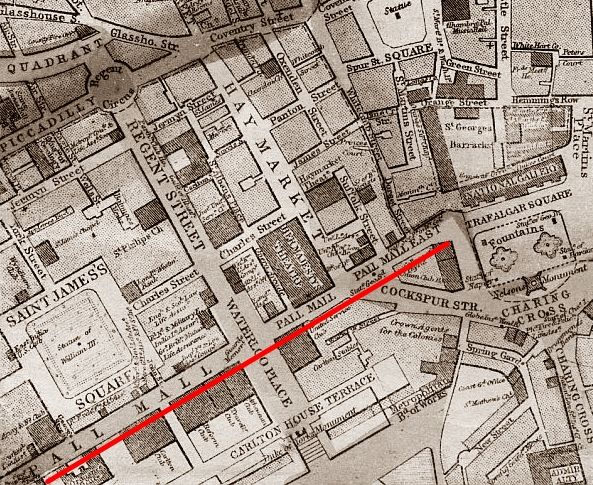 |
| Pall Mall, London |
The name, Pall Mall, derives from a game
that was popular in England during the seventeenth century. This game was
introduced from France, where it was called paille-maille, and
originated in Italy, where it was called pallamaglio, coming from the
Latin pila – ball and malleus – hammer.
 |
| Games with the Ball |
Ball and mallet games
have a long history – in ancient Rome there was a game called paganica,
where a leather ball stuffed with feathers was struck with a stick, and in
England during the reign of Edward III, cambuca was played, this was
also called bandy ball, on account of the bandy, or bent,
stick. In one incarnation, this game developed into golf, or goff as it
was sometimes called, and another variation became pall mall.
 |
| Pall Mall |
In his Latin
Dictionary (1735), Adam Littleton gives the definition of paganica
as ‘a goff ball, a stow ball, stuffed with feathers’, stow ball was a
similar sort of game to golf.
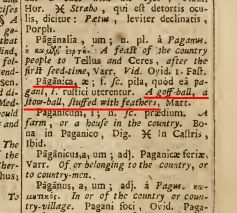 |
| Adam Littleton - Paganica - Latin Dictionary - 1735 |
An alternative etymology posits that the name
comes from pale-mail, French for straw-mallet, as the target
hoops were made from twisted or plaited straw, although ball-mallet
makes much more sense.
 |
| Jeu de Mail - Fifteenth Century |
Jeu de mail (mallet-game) was played in France in
the fifteenth century, as were other kinds of ground billiards, and continued
well into the twentieth century; jeu de palme (hand-game) eventually
developed into tennis, and such sports as cricket and lacrosse were later
versions of these stick and ball games.
 |
| Jeu de Mail - France 1895 |
The earliest mention of the game is
made in Method for Travel (1598), by Sir Robert Dallington,
“Among all the exercises of France, I prefer none before the Paille Maille, both because it is a gentlemanlike sport, not violent, and yields good occasion and opportunity of discourse as they walke from one marke to the other.”
The
enthusiasm for ‘gentlemanly’ sports is also seen in the Basilikon Doron (Royal
Gift), written by James I as advice for his eldest son, Prince Henry
(born 1594),
“But the exercises that I would have you to use (although but moderately, not making a craft of them) are running, leaping, wrastling, fencing, dancing, and playing at the caitch or tennise, archery, palle maille, and such like other faire and pleasant field games.”
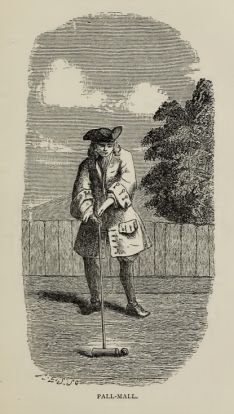 |
| Pall Mall |
It seems that the
Prince followed this fatherly advice, for a later anecdote records,
“At another time playing at goff, a play not unlike to pale-maille, whilst his schoolmaster stood talking with another, and marked not his highness warning him to stand farther off, the prince thinking he had gone aside, lifted up his goff-club to strike the ball.”
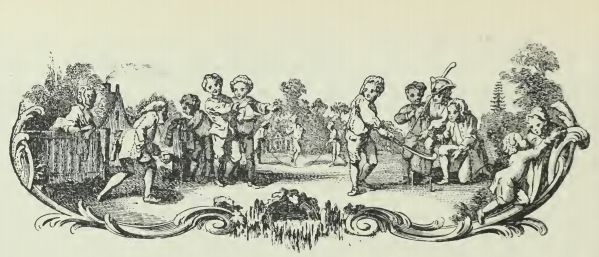 |
| Games with a stick |
Not long after, the younger Henry Peacham,
in the Compleat Gentleman (1622), describes the habits of the French,
“Their exercifes are for the molt part Tennife play, Pallemaille, fhooting in the Croffe-bow or Peece, and Dancing,”
The same author, in The Worth of a
Penny (1644), describes the beneficial pleasures of the body as,
“Walking, riding upon pleasure, hunting, hawking, bowling, ringing, Paile Maille or Pell Mell, and the like which are recreations without doors [i.e. outdoors].
 |
| Pall Mall Mallet and Ball |
On
April 2nd 1661, Samuel Pepys wrote in his Diary that,
“So I into St. James's Park, where I saw the Duke of York playing at Pelemele, the first time that ever I saw the sport.”
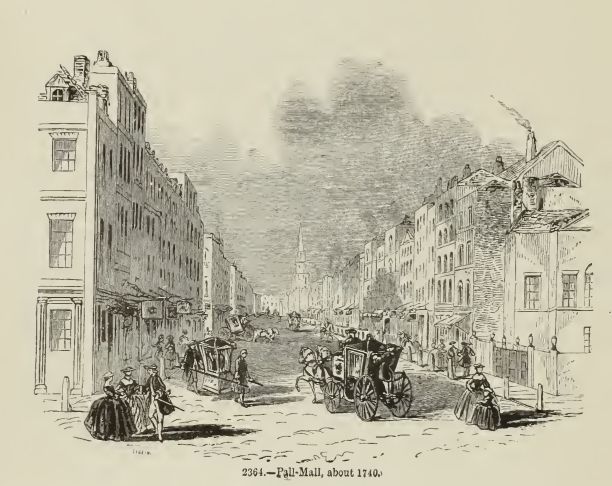 |
| Pall Mall circa 1740 |
This Duke of York would become King James
II, after the death of his brother, King Charles II, who was also extremely
fond of playing Pall Mall. The poet, Edmund Waller, wrote about the King’s
expertise in the game in his On St James’s Park,
“Here, a well-polished Mall gives us the joyTo see our Prince his matchless force employ;His manly posture, and his graceful mien,Vigour and youth, in all his motions seen;His shape so lovely, and his limbs so strong,Confirm our hopes we shall obey him long.No sooner has he touched the flying ball,But 'tis already more than half the Mall;And such a fury from his arm has got,As from a smoking culverin 'twere shot.”
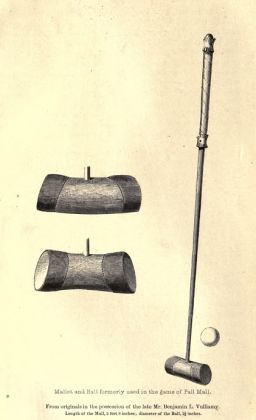 |
| Pall Mall Mallet |
Pall Mall was played with a mallet, its head bound with iron
hoops, and a box-wood ball that was struck down a course and then through a
suspended hoop, the winner either taking the fewest strokes or managing the
feat in a pre-determined number of strokes (similar to par in golf).
 |
| The Game of Pall Mall |
The
target hoops were positioned at either end of the straight alley, or field, and
play would continue from one end and back to the other, for a given number of
times. The alley itself was contained by boards, to prevent the ball from
running off and to prevent onlookers encroaching onto the playing area, and was
covered in powdered cockleshells, pressed firmly into the ground (the ‘well-polished
Mall’ mentioned by Waller).
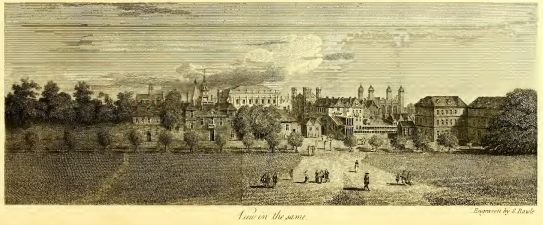 |
| Playing Pall Mall at St James's |
Pepys in his Diary, May 15, 1663, writes,
“I walked in the Park, discoursing with the keeper of the Pell Mell, who was sweeping of it, who told me of what the earth is mixed that do floor the Mall, and that over all there is cockle-shells powdered, and spread to keep it fast; which, however, in dry weather turns to dust and deadens the ball.”
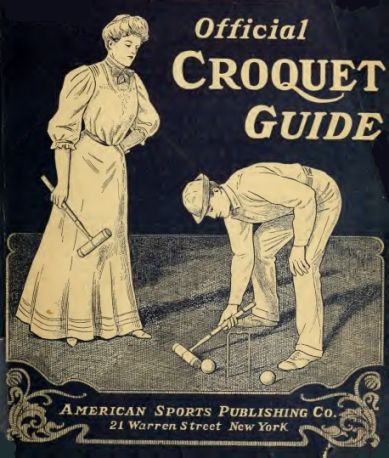 |
| Offical Croquet Guide |
Eventually, Pall Mall fell out of favour and the game developed into croquet,
still played widely today. The word 'mall' meaning a long, straight thoroughfare has since come to mean a shopping street, notably in the 'shopping malls' in the U.S.A.
 |
| A Rover - Croquet Principles and Rules - 1874 |
Oddly, the expression ‘pell mell’, meaning
disorder or confusion, does not come from the rushing after the ball during a
game of Pall Mall, but from the Old French pesle-mesle, a twelfth
century term meaning a mixture or mingling, possibly a rhyming construction
based on a word for a frying pan or a shovel.
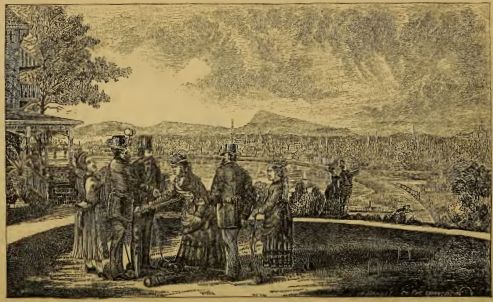 |
| A Croquet Party |
No comments:
Post a Comment